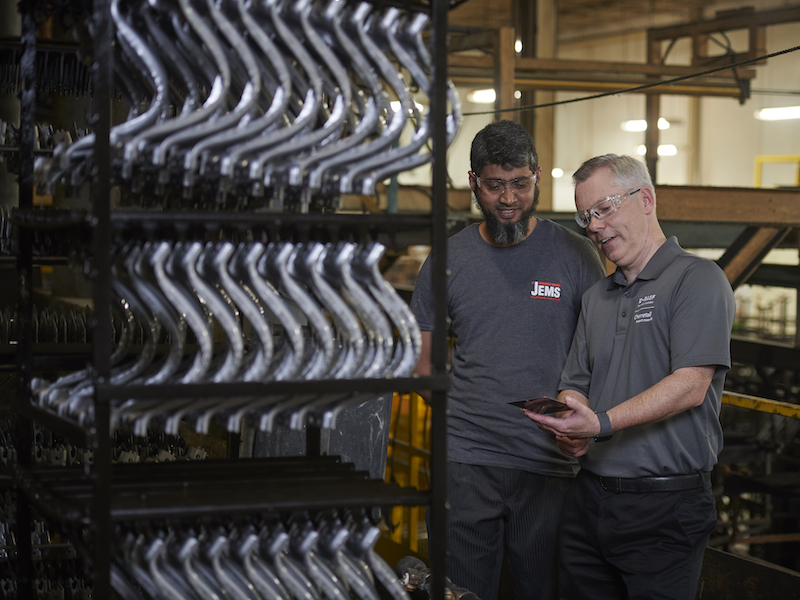JEMS Coating, the largest general industry electrocoating shop in Canada, provides top-quality electrocoat finishing for customer supplied metallic components used in automotive, electrical, construction, recreational, and general commercial industries.
Their focus is high volume automotive production. They have acquired OEM process approvals for automotive manufacturers such as GM, Chrysler, Mercedes Benz, Ford, Honda, Toyota, Nissan, and VW. Earning these approvals requires a very strong commitment to quality, service, and delivery, all of which reflect JEMS Coating’s dedication to their customers.
Robert German, majority owner of JEMS Coating, begins, “Our process flow features a seven-stage zinc phosphate pretreatment with a choice of immersion or spray, depending on the parts to be e-coated. Our success relies entirely on reliable, reproducible, and cost-effective production. We have established quality practices that we rigorously maintain, to identify, contain, and solve any issues that may arise so that our customers are not impacted.”
Mr. German continued, “For years, we have electrocoated most parts flawlessly with systems in place to ensure this. However, as a job shop, we face periodic setbacks tying into the variability presented by the lubricants and substrates of some of our customer’s product. What we needed was readily available, in-person, expert technical support.”
Daniel Mueller, Chemetall District Manager for Ontario, had this to say, “There are many challenges in the coating industry with respect to substrates, soils, performance specifications, and more. Today’s chemical pretreatment systems must be robust, cost-effective, and more importantly, supported by a local team of experts that can troubleshoot, diagnose, and resolve issues in a timely manner. Our team took a very systematic approach to resolving defects, optimizing the process, and providing cost savings. A perfect trifecta!”
The Gardo line solutions, offered by Chemetall, are based on advanced pretreatment products and synchronized process steps that result in a complete and effective automotive quality zinc phosphate coating on all substrates. The versatility of this multi-metal capability, with a focus on aluminum, make this customizable Gardobond solution an excellent fit for a shop like JEMS Coating.
Marino Zoratti, Senior Technical Sales Manager for Ontario explained, “We began the troubleshooting process by sending an assortment of parts back to our laboratories for process simulation and defect analysis. Our experts also reviewed every step of the electrocoating process at JEMS Coating. Based on our findings and our experience, we were confident that we could solve their challenges.”
Robert German agrees, “We granted Chemetall a one week trial in February of 2018 on our immersion line. The quality improvements and cost efficiencies were striking.
We no longer needed several additives. Further, the initial conversion itself was timely and flawless, an incredibly smooth and successful process. Chemetall experts, working closely with our experts, really came together with care and attention to deliver a safe and effective changeover. It was simply a fantastic partnership. As of the summer of 2018 we are in full production with our immersion line. We converted our much larger spray line during the 2018 winter holiday season. We are very satisfied. Today, both our immersion and spray pretreatment lines run Chemetall technologies.”
William Jones, Technical Service Manager for Canada adds, “Our Gardobond 24 process was developed to better engineer zinc phosphate processes to meet the ever- changing market demands. Chemetall is long known for innovation and excellence in technical customer support. Chemetall perfected the chemistry required to produce the crystalline morphology that creates the fine, smooth, and thin phosphate layer on multi-metal substrates, including aluminum. The key is the versatility of the solution we are able to offer JEMS Coating, as a job shop, so they can handle a variety of jobs efficiently.”
Chemetall, as part of its dedication to customers, and as a steward of the planet, identified two major trends in automotive OEM, that are now a crucial part of today’s manufacturing: light weighting, and multi-metal compatibility, with a focus on aluminum substrates. As a result, the Gardobond 24 process was further enhanced to become Gardo Flex, the next evolution of multi-metal zinc phosphate pretreatment.
An optimized zinc-phosphate layer gives excellent corrosion protection and paint adhesion properties. The characteristics of a phosphate system must be balanced, because a coating weight which is too high, with larger phosphate crystals can lead to poor paint adhesion, but a coating weight which is too low can give insufficient corrosion protection.
Flexible and Customizable
Gardo Flex allows for high through-put on all substrates, with an emphasis on aluminum and new substrates like ZnMg. Low temperature processes and less phosphate sludge reduce the costs of energy and maintenance. Minimizing phosphating time provides higher quality robustness. Customers benefit from multi-metal versatility, excellent cleaning, and ease of handling. Further performance enhancements are seen through reductions in waste water, tank temperatures, process costs, labor, hazardous materials, additives, maintenance, and even complexity.
JEMS Coating is also able to take advantage of the Chemetall proprietary Gardometer. The Gardometer can be used to measure zinc and manganese phosphate coatings on steel, galvanized, or aluminum sheet. It replaces ASTM and ISO weigh-strip-weigh with a digital option which is simple and easy to use, automatic, requires no technician, eliminates chemical wastes which increases safety, and provides instant results.
The performance requirements in the manufacturing of automobiles are constantly expanding: more functionality, higher speed, stylish design, and increased safety are all being demanded by consumers. To meet those expectations at a technical, cost-effective, and environmental level, new substrates are needed. Single materials alone are not the answer to this ever-increasing list of demands. The solution lies in combining materials. Hence, multi-material design is becoming more integral and with it, the need for a corrosion protection functionality with multi-metal capability.



































